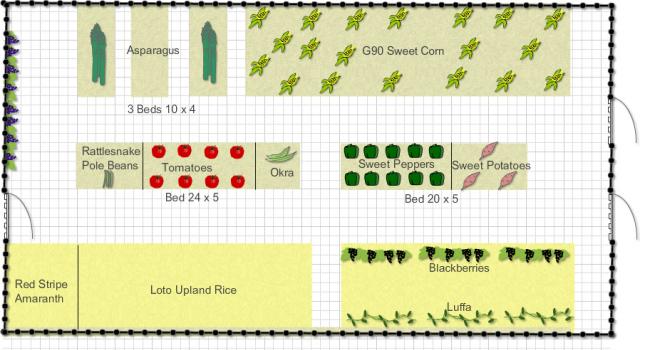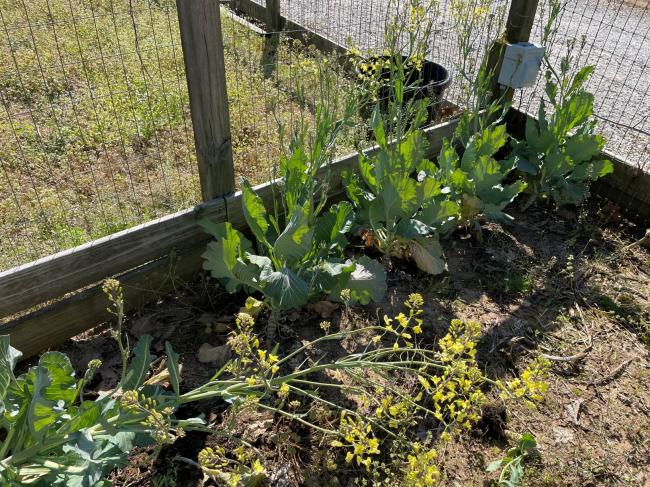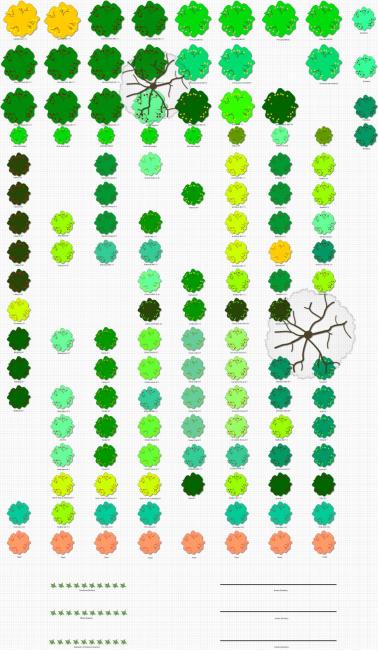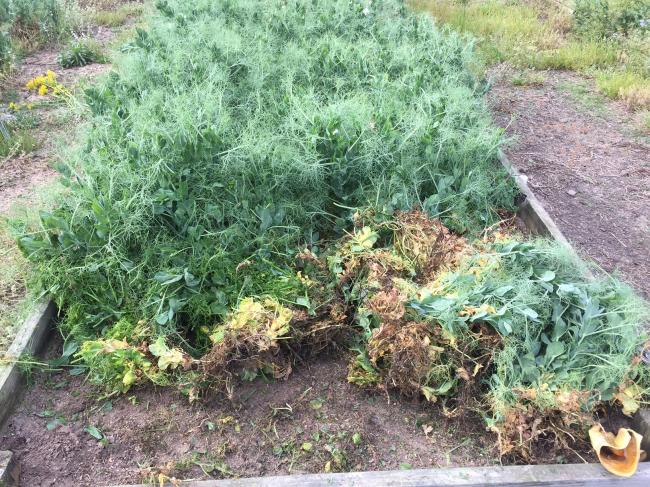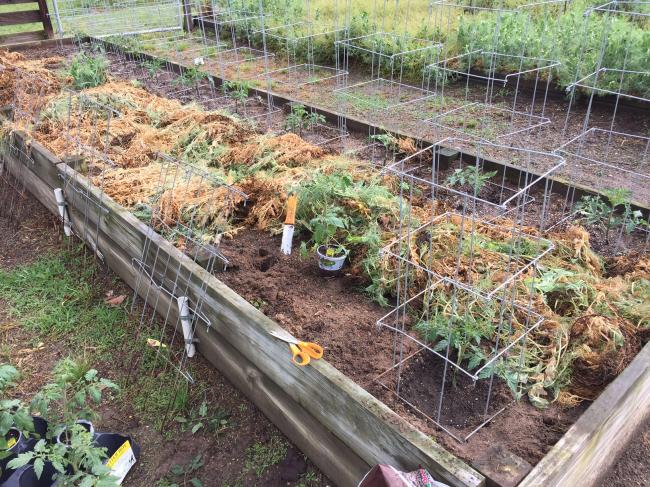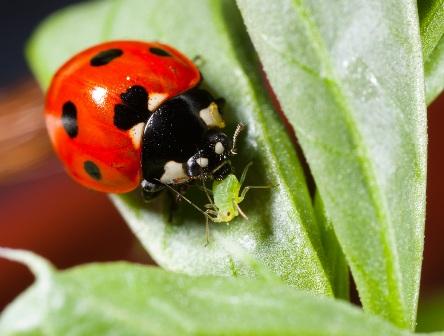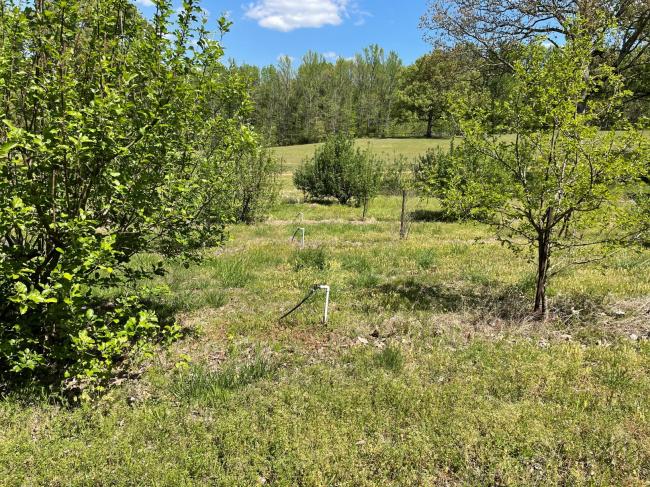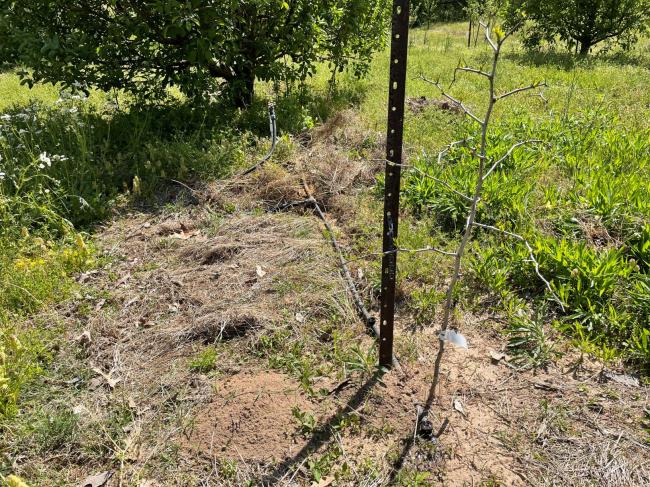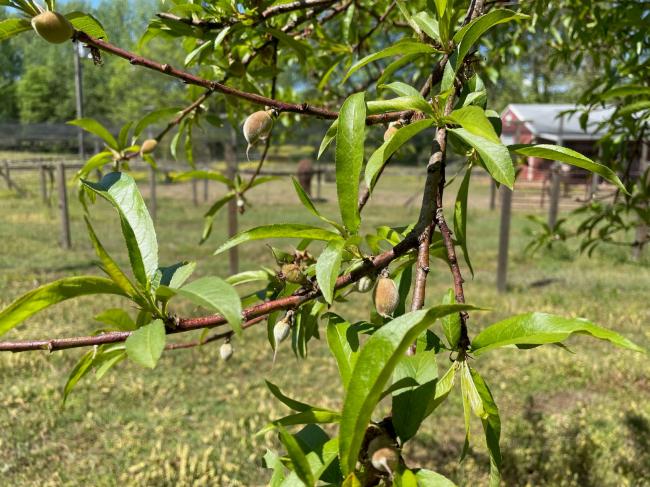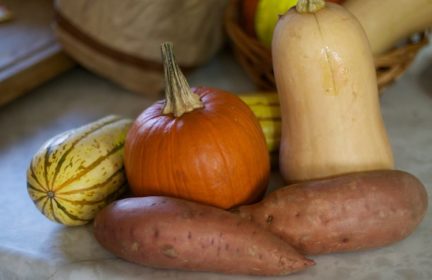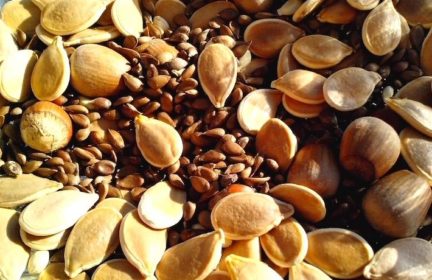Garden planner software
I’ve found that planning my garden each growing season is easier if I can actually see it to scale. For years I’ve been using Garden Planner 3, which has more features than I could ever use. It is not limited to gardens and can be used to layout most anything. I’ll just bring up a saved plan, do a save as command & then modify that plan. No need to start from scratch each time. Here is my garden plan for this summer.
-
Comments (35)
-
UbiqueContributor - April 15, 2021
Redneck,
Great garden planner and thank you for posting it. They are such a great tool and I am in the planning stages here. (That pesky last storm mostly dodged us, but we still did get some snow. I got the back yard beds moved and set up and eveything tidied up before the snow came.
My new planters for the front are inbound and eta is Apr 19. I had to order a separate one because of limits and that one landed yesterday, so it is set up in my living room. Setting up things in the living room has become a standing joke in the household.
My husband never knows what he will find in the living room. Last year I had 7 artificial Chrismas trees strung with an assortment of different warm white led lights and 2 floral arrangements with lanterns ready to be deployed outdoors through the front door. He was half asleep when he encountered the new forest in the living room. It was a moment for him 🙂
I put in a link for a gardening website I stumbled across “homestead and chill.” The photos of this young couple’s homestead are just wonderful. I love Deanna’s approach to gardening. It is structured but also looks natural and wild when you view it. She does 3 sisters planting also.
I’ve been wanting to post it for you to see, but now is a good time to make sure you see it.
I hope to post photos this year of my efforts. I just found the software for our old camera that we used for the iMac.
https://homesteadandchill.com/benefits-companion-planting-chart/
-
RedneckContributor - April 15, 2021
My garden never looks that pretty. 🙂
But I did plant my sweet corn & amaranth Tuesday. My English peas & snow peas are about 8″ tall now. Started picking asparagus this past week. Have to check those beds daily.
-
-
Robert LarsonContributor - April 18, 2021
Do you rotate crops every year or so to prevent certain nutrients from being depleted out of the soil?
Do you have a separate plan for your blueberries and such or does that always just stay the same? What happened to the collards?
That’s really neat Redneck I hope your garden grows well this year.
One suggestion: You should replace the sweet potatoes with regular potatoes. Because sweet potatoes are nasty!
-
RedneckContributor - April 18, 2021
Dude, and here I thought you were intelligent. 🙂 Sweet potatoes nasty? Slathered in butter with brown sugar on top? Or made into a tasty casserole with pecans on top?
Certain crops get rotated, especially the tomatoes & pepper. Disease is a huge issue with them. Obviously don’t rotate the asparagus, blackberries or muscadines. The pole beans always stay in that spot as legumes do better when planted in a bed that has grown them before. Has to do with the microbes which help them fix nitrogen in the soil. Right now, snow peas are growing up those trellises. My amaranth stays in the same spot. Nothing bothers it. However I grow collards in that amaranth bed during the fall/winter.
The rice bed had a three sisters garden there last year. This is my first attempt at growing upland rice. That corn bed always grows corn as it is my only available large bed. Not worried about diseases in the soil for corn but do understand I have to fertilize it, as it will sure deplete the soil. I will plant Austrian Winter peas in that bed next fall to help rebuild the soil.
So I pulled up most of the collards to make room for the amaranth I planted last week. I did leave a few collards on the back to allow them to go to seed.
My blueberries & main muscadine area are in the orchard, down at the bottom. They are enclosed by fencing & netting with access gates in the paddock. Below is an old, partial plan of the orchard. I don’t use this software for the orchard anymore, as I change out trees pretty often & it is easier to do in my private blog. When out in the orchard, like I was today spraying, with the blog, I can view it easily on my phone & can check to see what variety any given tree is now. But at bottom left are where my blueberries are & bottom right is now my main muscadine area. My blueberries are completely leafed out and are almost done with their blooms. Last two weeks there have been hundreds of bumblebees in there. I’m normally not scared by them but when I went in there to cut with the riding mower, I had to brush up against each bush (all about 6’+ tall) to get the grass underneath. That was bothering the bumblebees and they were buzzing me like crazy… but never attacked. They will attack when threatened, so I tried to not move too fast. The muscadine are just now budding out.
-
Robert LarsonContributor - April 19, 2021
You’re pretty smart with what you are growing. Knowing about microbes fixing nitrogen in the soil and which ones need to be rotated through. How do you learn all this? I haven’t seen anything like that on the back of the paper seed packet.
And yes, sweet potatoes are gross
-
RedneckContributor - April 19, 2021
You must be a Yankee. 🙂 I learn from experience and from reading a lot. My degree is in Biology so I like to understand the mechanism of how things in nature work. Most people know legumes fix nitrogen. I just like to know how.
Legumes don’t come ready to fix nitrogen in the soil. What actually happens is a bacteria in the soil, Rhizobium leguminosarum, “infects” the legume which creates the nodules that fix the nitrogen. If you are planting a legume in garden soil for the first time, it is recommended that you purchase soil inoculant to add with the seed. This inoculant is that bacteria. Once you have added the bacteria, you no longer need to add again, at it is now part of your soil. That is why I am growing my snow peas in the same spot as my summer pole beans… both are legumes. My English peas are currently growing in that bed where the sweet potatoes & peppers will be this summer. I grow them each spring in that bed, so that bed also is ready for legumes. The ability of legumes to fix nitrogen in the soil is not just for the soil… it also helps the plant itself. Here is an article that might help. https://www.gardeningknowhow.com/edible/vegetables/beans/soil-inoculants.htm
Not certain if it is on the seed packets but usually you will find this in the growing info section on the website. I brought up peas on the Burpee website and in that section, it starts with the following:
Because peas are members of the legume family of plants, they can benefit from an application of a soil inoculant designed for beans and peas, prior to planting. The inoculant will enable the plants to take nitrogen from the air to use as fertilizer, which can increase crop yield and quality.
-
Robert LarsonContributor - April 19, 2021
What do you think about taking 1/2 of your legume nitrogen enriched soil at the end of each season and put that into say your delicious sweet potato bed. Then take 1/2 of your old sweet potato bed and put it in the legume bed and mix it to then have your legumes the next season add nitrogen into that soil too.
Kind of like a fluid exchange on your vehicle. You empty your brake fluid reservoir and put in new fluid. It’s not as good as a full flush of the brake lines, but replacing half with new fluid is better than nothing.
Put those beans to work!
-
UbiqueContributor - April 19, 2021
Robert,
Mother Earth News is a good website for learning about gardening. They have articles on companion planting and crop rotation.
I also like Homestead and Chill run by Deanna and Aaron. They have a beautiful home and garden. She has a great approach and is super knowledgeable and great at explaining things.
-
RedneckContributor - April 19, 2021
My favorite magazine. I have a subscription for the printed version. It is an incredible resource for preppers. A few issues back, they had an article about cover crops.
-
UbiqueContributor - April 20, 2021
They are great. It is one magazine that I wish I could get the back copies in a “book” version for my library.
I was going to write earlier but was doing the final adjustments on some planters. They go outside tomorrow or the day after.
I wanted to run something past you regarding starting seeds and see if you think it might work.
There is a place inside my house that I think I can convert to a cabinet with lights and pullout glass shelves for seed starting. I would have to use a small ladder to get up to the shelves for watering. It wouldn’t be a greenhouse, but it would be better than nothing.
It is the area above my basements stairs. I can cleat the bottom and build the cabinet up 4 feet toward the ceiling over the basement stairs. This could be done without interference for head room descending the stairs. The electricians can run the wiring for the lights quite easily as it is adjacent to the area.
The side of the cabinet would be perpendicular to the back door which is the one mainly used. I think I can work around any cold blasts coming from the door being opened. I was thinking seed heating pads?
I was going to build a cabinet above the stairs anyway for storing more preps (it was wasted space), so if this doesn’t work, it wouldn’t create wasted effort or resources.
I’m trying to figure out what to do with the seedlings once they need transplanting. There a couple of other areas in the house (my den, living room and over the deep freezer where I could place shelving.
How do you handle the space requirements for the jump from seedling to transplant? And, do you think the idea is worthwhile? I would be doing this for next year.
-
RedneckContributor - April 20, 2021
In my climate, by the time I’m ready to take from the trays, I can either go ahead & plant or transfer to larger pots that stay out in the garden. With our long growing season, I start very little. This year, I started some jujube but they are a pain & hard to start. I see now where most use root suckers.
If you are building a cabinet, can you not provide heat into it, as opposed to pads? I use an inline duct fan to take room temp air from the house to our old cat in the garage. This keeps her warm in winter & cool in summer. You can get long sections of flexible ducting. The fan is mounted in the wall, under my feet here in my office, which is the wall between the garage & the house. Then just attached flexible ducting & ran it to her bed.
-
UbiqueContributor - April 20, 2021
Yes, I can use an inline duct fan *smacks my forehead*! That would work really well and is very easy to do. Thank you!
What you said about putting your seedlings that you do start out directly into the garden got me thinking that I can use my “greenhouse milk jugs plus blankets and place them on the South side of my house until I am ready to plant. I can use them to harden off the plants also.
Today is a plan and budget day, so I am also going to revisit my list of seeds to be started. We never did that on our farm. We just planted from seed. However, climate change has affected our Spring season. (I just watched a documentary a couple of days on it – Mutant Weather tv series). This means that we get a more unpredicatable Spring season now.
The cold snap got me last year and I had to replant. However, crop covers might work to protect the plants in early Spring. I am going to put those on to help protect the young plants.
I wonder if seeds are being selectively bred to account for climate change and seasonal changes? I’ll have to check that out.
Thanks again for the help with my seedling cabinet 🙂
-
RedneckContributor - April 19, 2021
That is a lot of work moving soil from bed to bed. Actually, all my beds are healthy because most falls, I plant a cover crop in them. I use Austrian Winter Peas but there are other choices as well. They fix nitrogen back into the soil over the winter and spring, and then I use the growth as green manure and a weed barrier. The Austrian Winter Peas stay green all winter and the leaves are delicious. Besides fixing nitrogen, they have large root systems that add organic matter back into the soil.
Here are some pics of that very bed a few years back, in late spring, where I’m killing off the peas & planting tomatoes using my trusty Hori Hori knife. Once all the tomatoes were in, I spread the pea plants all over as a mulch/green manure. You can see the background bed also has peas in it.
-
UbiqueContributor - April 20, 2021
I like your tomato cages. Did you make them? I have the round ones and they were too small for the tomatoes I grew last year.
Do you have trouble with aphids on your peas? I grew vanilla marigolds all through my raised beds last year. But the peas got the aphids. Everything else was fine.
I like the idea of using the peas as green manure.
I have soil to move around in the next day or so for the new planters plus mix some more and screen some soil that was recovered for reuse. I have a soil screener made from chicken wire and scrap wood. It works well.
I have to get the fence in next for the garden. That will probably be a go around the end of April or beginning of May. It depends on the weather.
-
RedneckContributor - April 20, 2021
No, I get them from Gardener’s Supply. They are very nice & fold flat when stored. I finally got smart a few years ago. Instead of getting a lot of crap for birthdays & Christmas, I asked for gift cards from here & Amazon.
https://www.gardeners.com/buy/tomato-cages/8587040.html
I haven’t had aphids in my peas but they do get on my muscadines. My go to insecticide, Spinosad, helps some but I usually spray with a mixture of Neem oil & insecticide soap for aphids.
-
UbiqueContributor - April 20, 2021
Awesome! Thank you!
I really like that they fold flat for storage. And, I like that gift card idea – nothing is worse than getting gifts that are impractical.
I’m going to check out Spinosad. I have heard of Neem oil, but have been using an insecticide soap.
The local nursery owner told me to use the garden hose for aphids. She said to lift up the leaves and blast them off with water, not so strong a flow as to hurt the plant.
I did do that, but I actually found I got much better results with companion planting. The vanilla marigolds and regular marigolds really help, as did lavender and mint.
I also made a spray out of garlic and water and used that for some pests. I’m careful not to use anything that can hurt or drive away the bees and other beneficial insects.
Also, I haven’t tried this yet, but somewhere in my reading, I saw something on clove oil as a deterrent for pests.
Thanks for reminding me of Neem oil. I am going to check it out.
-
RedneckContributor - April 20, 2021
Every gardener should know & use Spinosad. It is considered an organic insecticide and if used properly, only kills the bad bugs. Its primary action is achieved by bugs eating the sprayed plant… thus only killing the bad bugs. If you spray directly on an insect, it can kill so I spray around dusk when all my bees & pollinators have quit for the day. If sprayed as such, you won’t harm the good bugs.
-
Liz Klein - April 20, 2021
My mother used to buy ladybugs (or ladybirds as they say in the UK and maybe Canada) to eat aphids.
A ladybug will eat 50 aphids a day and about 5000 in their lifetime. Plus they are cute.
Except when they eat aphids. Then they are vicious looking!!!
Can’t get more natural than this. No pesticides required.
-
Liz Klein - April 20, 2021
While they are out of stock at the moment, this Canadian company sells them. https://www.thebuglady.ca/all-products
LADYBUGS:
Ladybugs are the most common predator of aphids, capable of consuming 50-60 per day!
They will also help control a variety of other pests including: thrips, mites, whitefly, mealybugs, leaf hoppers, and many other soft-bodied bugs.
250 ladybugs (22729): $20.00
suited for areas 50-200 square feet
1,000 ladybugs (22731): $40.00
suited for areas ~500 sq. feet
3,000 ladybugs (22730): $70.00
suited for areas of greater than 500 sq. feet
(Buy more than you think you need as you can store them for weeks in your fridge.)
-
RedneckContributor - April 20, 2021
We have plenty of natural ladybugs. For some reason, the last few years they have been almost invasive with thousands of them flying around & getting in the house. I just don’t have many down in the orchard where my main muscadine area is. But they do patrol my garden & I’m sure that is why aphids don’t bother my peas.
-
Liz Klein - April 20, 2021
Now how to figure out how to wrangle them and bring them down to the grapes.
haha Just imagining you running around with a bug net trying to catch them all.
-
UbiqueContributor - April 20, 2021
Our ladybug population has been dropping and I think it is because of the weed control spraying that is done. I am trying to stop this year’s spraying or at the very least get it away from my home and property.
Last year was so bad that the spraying caught me unawares on a walk. My lungs were affected. I couldn’t breathe properly and I had to turn around and head for home. I really wish they wouldn’t use that stuff.
-
UbiqueContributor - April 20, 2021
Thank you so much for the extra info, Liz. I will order some.
I also didn’t know I could store them in the fridge, so thank you for the info on that as well.
You made my day, big sigh of relief. I hand weed so the idea of chemicals is something I try to avoid 🙂
-
UbiqueContributor - April 20, 2021
Liz,
I can’t believe that I forgot ladybugs! Yes, ladybugs. It’s a standing joke around here that I rescue ladybugs and get them back outside if they get into house.
They are the best solution.
Thank you so much.
-
-
RedneckContributor - April 20, 2021
Just finished getting my drip irrigation hooked back up after being disconnected & drained for the winter. I have an underground main water line headed across all 8 rows in the orchard. Each row has its own hydrant. That way I don’t cross over any of the drip tubing as I drive up & down the rows. Below shows the hydrants and one pic shows a little jujube I planted a few weeks ago. You can see the drip line & the attachment to the hydrant. Jujube are slow to get going in the spring as the apple behind it is already leafed out & finished blooming.
Just a pic showing baby peaches.
-
UbiqueContributor - April 20, 2021
Nice irrigation system! As always I love the photos and I am so jealous.
Redneck, have you ever thought of writing a gardening book geared acreage use and all the experimental gardening that you do?
You are a very good writer and your photos are great. There is so much you could teach with your methods. Plus you could have a section for Mrs. Redneck and her recipes and photos of preserves and pound cake.
-
RedneckContributor - April 20, 2021
All these plants need their water, especially around here. My soil is rather sandy so it can dry out pretty quickly. Watered the garden this am and now will run the drip irrigation in the orchard for a day. Then I’ll turn on the drip irrigation in the blueberries/muscadines. Such a system is so easy to do & not very expensive, as the drip lines stay on the surface.
I’m not a writer but don’t mind posting my experiences on message forums. My goal is not to show what I have but to hopefully get a few people hooked on getting back to nature. I’m sure not a writer & would never consider a book. My wife was an English teacher and she loves to write poetry.
-
UbiqueContributor - April 20, 2021
Drip irrigation is the way to go, especially for the area you are working with and the amount of plants/trees.
The writing is something to consider. You could still retain your anonymity. Your writing style is comfortable to read which translates into a positive experience for the reader.
Good writing doesn’t have to formal. It can be crafted in the manner in which we speak and conversational in tone which draws the reader in.
I started by writing poetry and bridged to prose some years ago in order to challenge myself. I share your wife’s love of poetry. It is a different way to create imagery with words.
I really think you could do it well and still be anonymous. Your situation is also different. Most gardening books are drier than unbuttered toast to read, or they have been written by some academic where you need a science degree to understand what they are talking about.
A book about acreage and a sustainable garden written in a friendly, straightforward way, that is full of innovation, experimental projects by someone who is unabashed to say I am learning as I go and cares for beneficial insects is a winner as far as I’m concerned.
Plus, think of the people you could convert to collards. Hey? That photo of your simmering ham hocks and collards did it for me.
-
RedneckContributor - April 20, 2021
The drip irrigation is an integral part of my prepping… and a big reason why I have that expensive flex well pump in storage. If in a crisis & need to be self sufficient, then the last thing you want is crop failure due to a dry spell. Such a failure could mean death… not just disappointment. Seems to happen now more often than in the past. Our climate is really screwed up. I keep lots of tubing, fittings & emitters in storage so that I can use it on the expanded gardens during a crisis. Not enough for the entire expanded garden but I figure we would be able to move the setup from row to row.
You are one crazy lady! No on the writing but I did make another big pot of collards today. Made a big meat loaf & mashed potatoes. Delivered some to our elderly lady friend from church & most going into Memphis tomorrow with my wife for her mom & aunt. These old folks just love collards & they are incredibly nutritious.
-
UbiqueContributor - April 20, 2021
The supplies to set up drip irrigation is something I want in my preps for the same reason. It has a 70-80% water efficiency rate compared to 40% for open irrigation. An Indigenous reserve community hired Israeli consultants to teach them their irrigation methods.
I like the idea of having the know how and supplies on hand if needed.
I am thinking about if it is possible to construct a greenhouse in the back yard and grow in a greenhouse. It might help mitigate some of the effects of climate change. There are some very nice greenhouse plans that look good. It could extend the growing season also.
Yeah, I’m crazy like a fox! I’m wearing you down on that writing. “No” is just a “maybe” that hasn’t happened yet.
I love meat loaf and make a good one. Do you mix up mustard, brown sugar and ketchup and put it on top before you bake it? I want collards and meat loaf. Why do I get hungry reading your replies?
My planters are going out tomorrow and then a whole lot of wheel barrowing and shovelling. We’re getting to 12 Celsius tomorrow!
-
RedneckContributor - April 21, 2021
Meat loaf topping is ketchup, apple cider vinegar, brown sugar, Worcestershire sauce & a bit of onion.
-
UbiqueContributor - April 21, 2021
That sounds really good. I’m going to try that next time I make meat loaf.
Thank you.
-
RedneckContributor - April 21, 2021
4 tbs vinegar 4 tbs brown sugar 2 tbs Worcestershire sauce 1/2 cup ketchup 1/4 cup chopped onion Depending on who I cook for, I sometimes omit the onion & just use a bit of onion powder.
-
UbiqueContributor - April 21, 2021
I have the recipe written out and thank you very much for posting it.
I found dehydrated onions at Costco and put some away in my pantry for prep and regular use. They are actually pretty good. I use onion powder also sometimes.
We need a recipe section. We could call it “prep-icpes.”
Okay, I am being far too silly. The remedy is for me to get to work. I’m dragging my feet a bit because this involves working on the difficult neighbor side, but the security cameras will be a deterrent. Once those planters are situated there is more of a barrier. So, onward!
-
Gideon ParkerStaff - April 21, 2021
We do have a few blog posts on recipes that can be made with commonly found food storage items. I think I’ll skip on the pinto bean fudge though…
-
-
- News for the Week 2024-11-18 - 3 hours ago
- News of the Week 2024-12-30 - 4 days ago
- How to sew and repair a leather glove - 3 weeks ago
- Moooooooo…Can you rec a powdered milk? - 3 weeks ago
- Light weight backpacking gear and techniques - 3 weeks ago
This forum is heavily moderated to keep things valuable to as many people as possible. Full community policies are here. The basics:
- 1. Be nice to each other.
- 2. Stay focused on prepping.
- 3. Avoid politics, religion, and other arguments.
- 4. No unfounded conspiracies, fake news, etc.
- 5. Debate ideas, not people.
